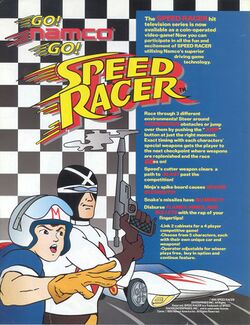Namcokid47 (talk | contribs) mNo edit summary |
Namcorules (talk | contribs) (Level up x3!) |
||
| Line 1: | Line 1: | ||
{{Header Nav|game=Speed Racer (1995)|num= | {{Header Nav|game=Speed Racer (1995)|num=3}} | ||
{{Game | {{Game | ||
|title=Speed Racer (1995) | |title=Speed Racer (1995) | ||
| Line 15: | Line 15: | ||
|series=Speed Racer | |series=Speed Racer | ||
}} | }} | ||
'''Speed Racer''' is a {{c|racing}} arcade game that was released by [[Namco-America]] ([[Namco]]'s United States division) in [[1995]]; it's the only other game that utilises the same hardware as their Japanese division's [[Final Lap R]] (an Intel I960KB running at 20 MHz and a Motorola M37702 running at 16.384 MHz, with a C352 custom sound chip running at 16.384 MHz for audio). Based upon Tatsunoko Production and Yomiko Advertising's 1967 anime series of the same name, up to four players may play this game simultaneously, when a pair of two-player cabinets are linked together - and they must use a steering wheel, a pedal and three buttons to take up control of one of five characters from the show (including Ninja and Snake, in addition to Speed himself, and each one has their own unique car and weapons) in one of three different environments. Unlike in any of Namco's earlier racing games the players can jump over obstacles if they push the appropriate button at the right moment; the company's signature character, [[Pac-Man]], also appears above their logo during its attract mode (in anthropomorphic form). | {{game disambig|the [[1995]] [[arcade]] game|the [[1994]] [[Super Famicom]] and [[1996]] [[Sony PlayStation]] games|[[Speed Racer (1994)]] and [[Speed Racer (1996)]]}} | ||
'''Speed Racer''' is a {{c|racing}} arcade game that was released by [[Namco-America]] ([[Namco]]'s United States division) in [[1995]]; it's the only other game that utilises the same hardware as their Japanese division's [[Final Lap R]] (an Intel I960KB running at 20 MHz and a Motorola M37702 running at 16.384 MHz, with a C352 custom sound chip running at 16.384 MHz for audio). Based upon Tatsunoko Production and Yomiko Advertising's 1967-68 anime series of the same name, up to four players may play this game simultaneously, when a pair of two-player cabinets are linked together - and they must use a steering wheel, a pedal and three buttons to take up control of one of five characters from the show (including Ninja and Snake, in addition to Speed himself, and each one has their own unique car and weapons) in one of three different environments. Unlike in any of Namco's earlier racing games the players can jump over obstacles if they push the appropriate button at the right moment; the company's signature character, [[Pac-Man]], also appears above their logo during its attract mode (in anthropomorphic form). | |||
{{Continue Nav}} | {{Continue Nav}} | ||
Revision as of 22:00, 19 January 2019

| Speed Racer (1995) | |
|---|---|
| Developer(s) | Namco-America |
| Publisher(s) | Namco-America |
| Year released | |
| System(s) | Arcade |
| Preceded by | Speed Racer in My Most Dangerous Adventures |
| Followed by | Speed Racer (1996) |
| Series | Speed Racer |
| Japanese title | スピードレーサー |
|---|---|
| Genre(s) | Racing |
| Players | 1-4 |
| Modes | Single player, Multiplayer |
- This guide is for the 1995 arcade game. For the 1994 Super Famicom and 1996 Sony PlayStation games, see Speed Racer (1994) and Speed Racer (1996).
Speed Racer is a racing arcade game that was released by Namco-America (Namco's United States division) in 1995; it's the only other game that utilises the same hardware as their Japanese division's Final Lap R (an Intel I960KB running at 20 MHz and a Motorola M37702 running at 16.384 MHz, with a C352 custom sound chip running at 16.384 MHz for audio). Based upon Tatsunoko Production and Yomiko Advertising's 1967-68 anime series of the same name, up to four players may play this game simultaneously, when a pair of two-player cabinets are linked together - and they must use a steering wheel, a pedal and three buttons to take up control of one of five characters from the show (including Ninja and Snake, in addition to Speed himself, and each one has their own unique car and weapons) in one of three different environments. Unlike in any of Namco's earlier racing games the players can jump over obstacles if they push the appropriate button at the right moment; the company's signature character, Pac-Man, also appears above their logo during its attract mode (in anthropomorphic form).
-
Namco logo, ft. Pac-Man.
-
Game's copyright screen.
-
The game's title screen.
-
1-player upright cabinet.
-
2-player upright cabinet.
-
Screenshot of the game.





